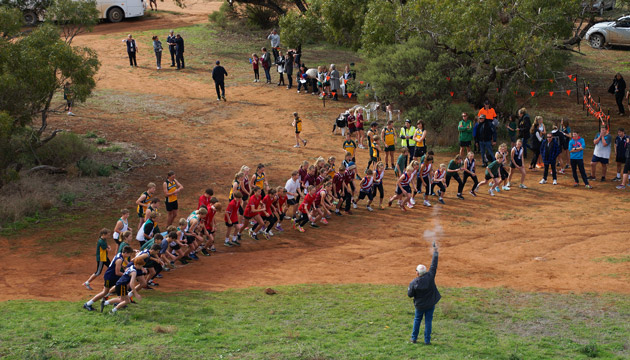A geography teacher on the Eyre Peninsula, SA, started a wild cross-country run that has now been going for 41 years.
Story and photos Liz Davis
In 1977, geography teacher John Gascoyne arrived at the new Karcultaby Area School on the Eyre Peninsula, SA. The school – built in a paddock between two towns: Minnipa, 18 kilometres to the east, and Poochera, 15km west – was planned to cater for up to 250 students from reception to Year 12. Around the school there was not a tree in sight, and the students brought their own rainwater to drink.
John thought that something was needed to introduce the virgin school to the well-established places of education on the Eyre Peninsula. “I wanted to put Karcultaby on the map,” John says. “Very few people had heard of it and it needed something to spark it up. I thought about a monster marathon, perhaps running from Ceduna to Karcultaby, and maybe involving footballers and netballers.”
Instead, he came up with a cross-country run and invited other schools to come. “The first race was run around the school, over the railway line and down to the old Karcultaby shop ruins,” John says. “It was very ordinary. Even at that stage I was thinking Tcharkuldu was a better venue.”
Tcharkuldu is a spectacular granite inselberg, strewn with boulders and surrounded by mallee scrub, situated approximately 6km out of Minnipa. It sits on 200 hectares of crown land managed by the Minnipa Progress Association and has picnic facilities, a public toilet and campgrounds, and is open to the public. From the top of Tcharkuldu there is a magnificent 360-degree view and the dark blue tinge of the Gawler Ranges is clearly visible in the distance to the north. A network of low gutters skirts parts of the rock to collect and channel rain water into a large dam, and for a long time this was the main water supply for Minnipa township.
John plotted a cross-country course over the hill. “I thought a 20-minute run would be about right,” he says. He asked another teacher to ride a motorbike around the course to check the distance. It was set at 5km, and the following year the Karcultaby cross-country run moved to Tcharkuldu.
The course begins easily enough, with a flat kilometre around the base of the hill, before veering suddenly onto an increasingly steep rise up a goat track. This is the most taxing part of the run. The track then continues over the top of the hill, around enormous boulders, before opening up to an uncomfortable descent (particularly when wet) down a splay of uneven granite to solid dirt at the bottom. From there the course is relatively flat, crossing a grassy plain, circling a large dam and meandering through scrub until a long gentle incline brings competitors back to the base of the rock.
The track is carefully marked with white wooden stakes and each year the grassy parts of the track are mown. “It is a physically challenging race that tests your navigational skills, because you don’t want to get lost,” Year 10 Karcultaby student Joshua Horgan says. “It is the most challenging run I have ever done.”
Students come from schools across the Eyre Peninsula to compete in the Tcharkuldu race, held in July or August, and there is also an open race for parents, teachers and former students. In 2007, a 3km route was added for students in years 3–5 and in 2000 Tcharkuldu won the National Heart Foundation Kellogg’s Award for the Best Community Event of Physical Activity. Some schools use the Tcharkuldu course as a lead-up to higher profile cross-country events in Adelaide later in the year.
Hannah Petty, now a member of the Adelaide Thunderbirds netball team and captain of the 2017 Australian Netball World Youth Cup team, ran in the first Tcharkuldu primary race in 2007. “I loved competing there,” she says. “You weren’t only running against the best runners from other schools, but the rock itself was a challenge.” Ten years later, Hannah still holds the record for the primary event.
Tcharkuldu has run annually for 41 years. John moved on in that time, and was teaching at Ceduna for many years, bringing along his students to the run until he retired a few years ago. In 2017, 314 competitors from 11 schools attended the event, including a large number of primary competitors. Karcultaby school students are also actively involved either as markers along the track or providing lunch for the hundreds of contestants, spectators and visitors.
This story excerpt is from Issue #116
Outback Magazine: December/January 2018










